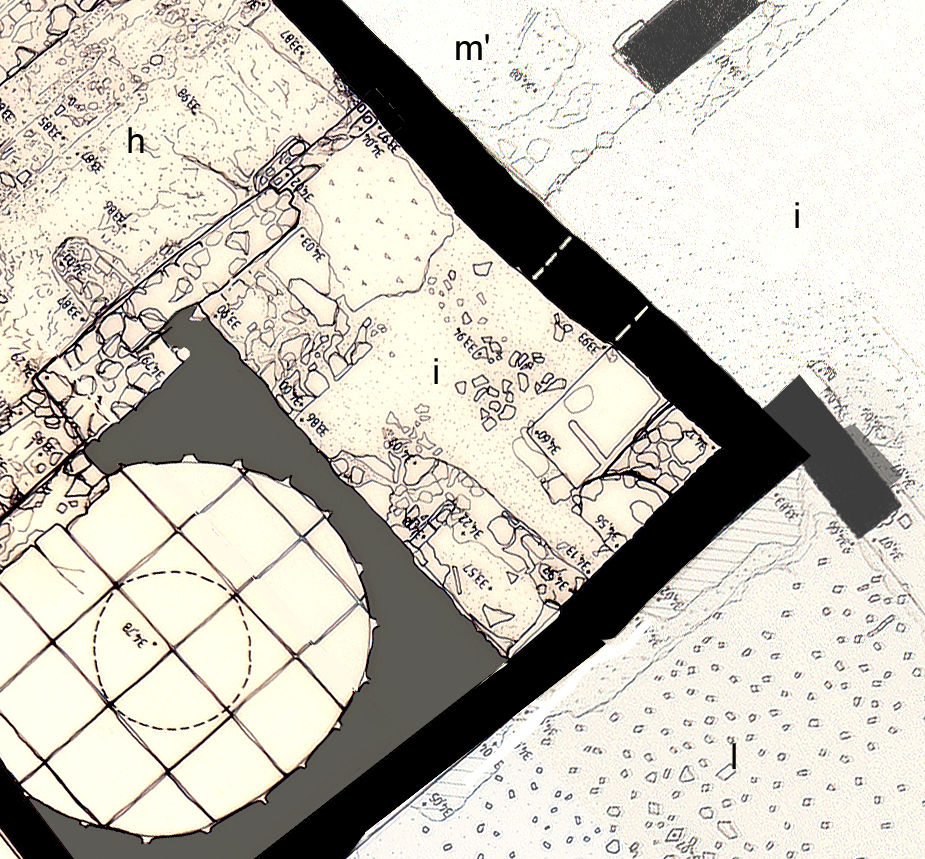Floor
Description
Henrik Boman & Monika Nilsson
The lavapesta floor is preserved only in the northern part of room i, in front of the threshold. Three installations take up much floor space, but in the central, open part of the room there are no traces of floor coating. Instead, the soil is very loose in texture and contains numerous pottery sherds, plaster fragments and charcoal.
The concentration of pottery and plaster continues well below the floor level of 79 AD. Accordingly, the material was probably used as floor bedding, but we could not determine the border between ancient dump level and modern.
Threshold
The lava threshold is broken, with the central part completely missing. The side facing the room is cut to a lower level; the threshold was designed for a two-parted door opening inwards and there are still traces of iron in the pivot hole to the east. On the higher, exterior part are rectangular holes at each end, probably to support a wooden doorframe.
SE corner
In front of the SE corner is a large limestone block that presumably is the structure Mau interpreted as a staircase (Mau 1877, 133). It was deduced, however, that the boulder has been placed here post-excavation, but in between the boulder and the S wall is a built structure. It consists of two elements: a quarter-shaped bench to the west and a lower rectangular bench to the east.
Of the three installations in the room, the bench in the SE corner is described separately (see Room iFeatures to the right). As for the other two, the remains were not recovered in good condition and could not be investigated satisfactorily.
NW corner (Hearth)
Upon entering the room, the right side of the entrance is occupied by a flimsily built, square structure which continues down, below floor level. It is placed against the NW corner with a limestone boulder to the east and a row of small to medium sized stones (lava and limestone) to the south as demarcation. Within are more small lava stones enclosing a round hollow with dark brown soil, lime pellets, charcoal and small bones. This installation was interpreted as a hearth.
SW corner (Latrine)
In the SW corner is the very small, rectangular toilet booth. Its N-S wall/base to the east probably had a corresponding wall/base to the west originally, but it was replaced with the side of the oven. To the north is the entrance near which lies a thin slab of marble.
Little remains of the superstructure. Within is the circular opening of the cess pit in which fragments of a large, flat tile rested on the pumice. The instability of the structure prevented us from clearing the pit.
The oven (z) was built later than the latrine and encroached upon its western side. It still appears to have been in use in 79 AD because it was filled with pumice from the eruption. The presence of pumice demonstrates that the cess pit had not been filled in or effectively sealed, thus it was in all likelihood still utilised. Also, no other toilet has been found in the bakery.
The quantity of plaster fragments in this room is significant: the lack of stones in the material might indicate that this is a dump of material after a redecoration, when the wall plaster has been removed. The pieces of painted plaster consist of black fragments with white lines, minute green pieces and a few red-painted parts.
The modern piece of plaster found under the large limestone block indicated that the room has been used as dump prior to the large deposition of earth that we found here in 2002. The line between the Roman filling material and the modern dump cannot be determined.

